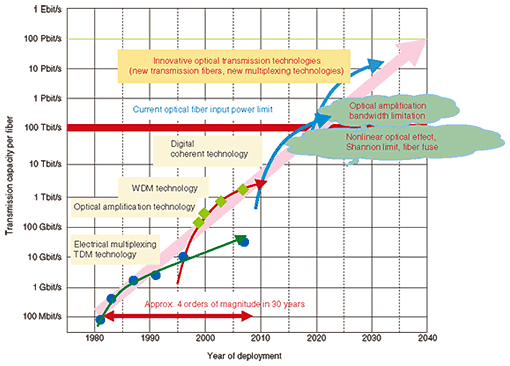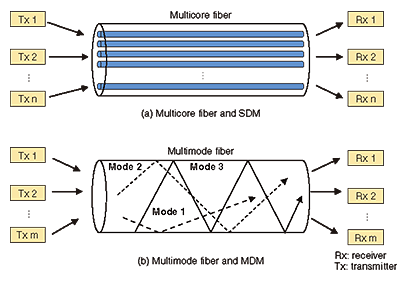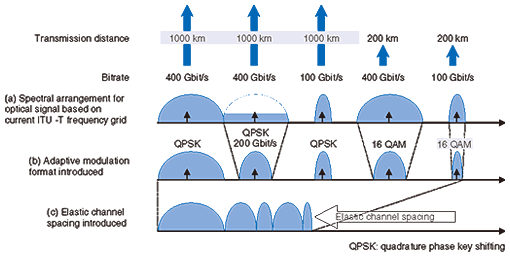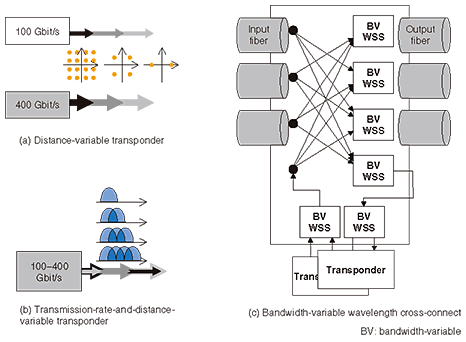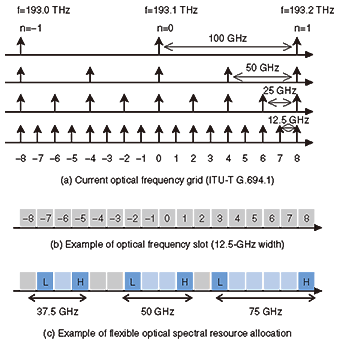 |
|||||||||||||||||||||||||||||||||
|
|
|||||||||||||||||||||||||||||||||
|
Feature Articles: Ultrahigh-speed Ultrahigh-capacity Optical Transport Network Vol. 9, No. 8, pp. 40–47, Aug. 2011. https://doi.org/10.53829/ntr201108fa6 Innovative Future Optical Transport Network TechnologiesAbstractThis article introduces two initiatives by NTT—innovative optical transmission technology and elastic optical path networks—as ways to achieve rapid enhancement of the optical network in order to meet the demand for a thousand-fold increase in information volume and to fully utilize the potential of existing optical fiber.
1. IntroductionTraffic in core networks is increasing at several tens of percent per year, and we are searching for innovations in optical transmission technology for the long term that will enable the transmission of a thousand times as much information and innovations in optical networking technology for the mid-term that will lead to maximal utilization of the potential of existing optical fiber [1].
Optical transmission technology has developed rapidly over the past thirty years through three main technological innovations, as shown in Fig. 1: time division multiplexing (TDM) technology based on electrical multiplexing, optical amplification technology combined with wavelength division multiplexing (WDM) technology, and digital coherent technology, which is currently undergoing research and development. Although transmission technology research has reached a total capacity per fiber of 100 Tbit/s and progress is still being made, when we consider how to attain even higher capacities well above 1 Pbit/s, we find that optical fiber as a transmission medium and the existing multiplexing technologies such as TDM and WDM are facing their limits. Accordingly, to achieve a rapid increase in capacity beyond a 1000-fold, as indicated below, we need innovative optical transmission technology that will overcome the physical limits. In the current optical networks based on WDM, optical signals are arranged on a fixed-spacing (e.g., 50-GHz) frequency grid standardized by ITU-T (International Telecommunication Union, Telecommunication Standardization Sector) and the same modulation technology has been used for optical signals of the same bitrate regardless of the transmission distance. So far, higher capacities per fiber have been achieved by improving the spectral efficiency (SE) by increasing the bitrate per channel while keeping or even narrowing the channel spacing. The abovementioned concern about approaching the capacity limit of conventional optical fibers has triggered recent vigorous efforts to investigate elastic optical path networks [1]-[3], where the required minimum spectral resources are allocated adaptively to an optical path according to the data volume and path length in order to improve the SE at the network level. Optical transmission technology as a long-term initiative of NTT¡Çs R&D is introduced in section 2, and elastic optical path network technology as a mid-term initiative is introduced in section 3. 2. Optical transmission technology initiativeThe first limiting factor facing existing optical transmission technology is the optical fiber signal input power. Optical fiber transmits an optical signal through a small core that has a diameter of approximately 10µm. If the signal optical power exceeds a certain level, and the temperature of the core suddenly increases sfor some reason, the core melts, and thermal destruction called fiber fuse occurs and propagates towards the light source [2], [4]. In current optical fibers, the fiber fuse transmission threshold power is 1.2-1.4 W, but we anticipate that in the future as the transmission capacity increases, the signal power will approach this threshold. On the basis of the latest optical transmission experiments, the relationship between the product of capacity per fiber and distance (Pbit/s¡¦km) and the overall input signal power for an optical fiber is shown in Fig. 2, where the solid red line corresponds to 10 mW/(Pbit/s ? km). The overall input power will gradually approach the abovementioned fiber fuse transmission threshold value. For example, achieving 1 Pbit/s over a distance of 1000 km (1000 Pbit/s¡¦km) requires several watts of optical signal power. Accordingly, we need to develop an optical fiber that can withstand high power to overcome the fiber fuse and allow capacity expansion [5].
The second limiting factor is signal degradation due to the nonlinear optical effect in the optical fiber, whereby the optical signal phase and frequency are modulated depending on the signal intensity. If the signal power is increased in order to increase the communications capacity, WDM signal crosstalk is generated as a result of these effects, and the signal cannot be transmitted over a long distance. For this reason, we need to develop an optical fiber that suppresses the nonlinear optical effect. The third limiting factor is the SE. The SE limit (communication capacity per unit bandwidth) for a fixed signal-to-noise-ratio (SNR) is given theoretically by the Shannon limit*1 and, depending on the abovementioned nonlinear optical effect, the fiber capacity is further limited. To improve the SE for a fixed input power, we need new multiplexing technologies such as space division multiplexing.
The fourth limiting factor is the optical amplification bandwidth for the optical repeaters. The bandwidth for the 1.5-µm-band erbium-doped fiber amplifier used in linear repeaters is currently approximately 30–40 nm per band (L band or C band), so to increase the communication capacity, we must develop new wavelength bands for amplification. To resolve the abovementioned issues, we must research and develop new transmission media as well as new multiplexing technologies. 2.1 New transmission fibersToward transmission capacity expansion, we began research on a new optical fiber that has excellent power-tolerance characteristics and suppresses the nonlinear optical effect. For good power tolerance, new structures such as photonic crystal fiber and hole-assisted fiber are currently being investigated [2], [6]. Furthermore, we began investigation of a multicore fiber in which the power density per core is controlled to increase the overall transmission power (capacity) and a multimode fiber [7] in which signals are carried in individual spatial modes in a large-diameter core to expand the capacity. 2.2 New multiplexing technologiesNTT has begun to investigate the use of new multiplexing technologies such as space division multiplexing (SDM) and mode division multiplexing (MDM) in these new optical fibers. SDM and MDM are schematically illustrated in Fig. 3. MDM technology itself was proposed in the 1980s in short-distance transmission; in recent years, validation experiments using multiple-input multiple-output (MIMO) processing (from 2 ¡ß 2 to 3 ¡ß 3) have been reported. Along with the new transmission fibers to increase the power tolerance and suppress nonlinearity and with optical amplification bandwidth expansion through SDM and MDM, we are investigating ways to increase the transmission capacity by more than three orders of magnitude in the future.
3. Optical network technology initiative3.1 Elastic optical path networkThe essence of the elastic optical path network concept is adaptive spectrum allocation to an optical path. One benefit that the elastic optical path network yields is spectral savings achieved by exploiting spectral resources that had not been fully utilized. This results in an increase in network capacity. Opportunities for exploiting underutilized spectral resources are shown in Fig. 4. Let us consider an example in which we transport mixed-rate traffic. First, for client traffic that does not fill the entire capacity of a wavelength, the elastic optical path network provides intermediate bandwidth of an appropriate size, such as 200 Gbit/s. This makes the unused client bandwidth available for use. Second, for shorter optical paths, which suffer from less SNR degradation, we use a more spectrally efficient modulation format, such as 16QAM (16-state quadrature amplitude modulation). We utilize the excess transmission margin for shorter optical paths. Finally, combined with elastic channel spacing, where the required minimum guard band is assigned between channels, we can utilize the excess channel spacing. In this way, elastic optical path networks accommodate a wide range of traffic in a highly spectrally efficient manner.
Enhanced network availability is another important benefit of the elastic optical path network. When considering the multiple failures that may occur during a severe widespread disaster, there could be surviving detour routes, thanks to the mesh network topology. However, such detour routes may be unable to support sufficient spectral resources to transport the original data rate, and/or the length of the detour route could exceed the optical reach of the original optical signal. The unique features of adaptive spectral allocation and bandwidth/modulation-format optimization of the elastic optical network guarantee the minimum connection for high-priority traffic at the expense of bandwidth. 3.2 Enabling hardware technologyEmerging advanced modulation technology and the bandwidth-variable wavelength selective switch (WSS)*2 are two key enablers for the elastic optical path networks [8] [9]. By taking advantage of multilevel modulation and tightly spaced multi-carrier modulation based on optical orthogonal frequency division multiplexing (OFDM)*3, or Nyquist-WDM*4, we can select the optimum combination of three parameters for an optical signal, i.e., the symbol rate, number of bits per symbol, and number of subcarriers, in order to achieve the required optical reach*5 (Fig. 5(a)) and/or transmission capacity (Fig. 5(b)) while minimizing allocated spectrum resources. The bandwidth-variable WSS is a 1 ¡ß N switch or filter providing a continuously tunable and variable seamless transmission spectrum. The flexible bandwidth reconfigurable optical add drop multiplexers (ROADMs) and wavelength cross-connects (WXCs) that use bandwidth-variable WSSs based on liquid crystal on silicon (LCoS) or digital light processing (DLP) technologies enable the forwarding of channels having arbitrary spectral widths to arbitrary output ports (Fig. 5(c)).
3.3 Management and control technologyTo achieve the elastic optical path network, in which the required optical spectral resources are adaptively allocated to optical paths, we need a novel spectral resource notation scheme that expands the current ITU-T-standardized frequency grid (Fig. 6(a)). One promising approach is to introduce the concept of a frequency slot, as shown in Fig. 6(b). For example, in correlating the current frequency grid with the minimum channel spacing, a 12.5-GHz-wide frequency slot is considered as a candidate. By allocating consecutive multiple slots to an optical path, we can specify the required spectral resources [10] (Fig. 6(c)). The problem of calculating routes for optical paths in conventional transparent optical networks is called the routing and wavelength-assignment (RWA) problem with the wavelength-continuity constraint in the longitudinal direction along the route. Adaptive spectral allocation in elastic optical path networks introduces more severe constraints for spectrum-continuity in the longitudinal direction as well as on the frequency axis. We call this the routing and spectrum-assignment (RSA) problem. If the frequency slot concept is introduced, then the RSA problem results in a problem that can be solved by calculating a suitable route while guaranteeing the required number of consecutive slots along the route [8].
4. ConclusionIn this article, we introduced two technologies to support the future optical network: innovative optical transmission technology and elastic optical network technology. NTT is investigating, as a long-term initiative, transmission capacity expansion by more than three orders of magnitude by accelerating research on innovative optical transmission technology, namely new multiplexing technologies such as SDM and MDM used in a new power-tolerant and nonlinearity-tolerant enhanced transmission medium. Furthermore, as a mid-term initiative, the introduction of the elastic and adaptive control concept to the optical layer lets us effectively utilize the SE and we are advancing elastic optical network technology research. While promising various benefits, sthe elastic optical path network concept brings new challenges in achieving cost-effective solutions at both the operational and equipment levels. We anticipate that such challenges will be overcome and that the elastic optical path networking technology will provide a more efficient and highly available optical network infrastructure for the future Internet and services. References
|
|||||||||||||||||||||||||||||||||








